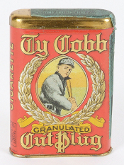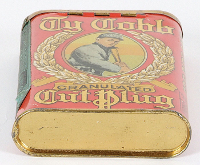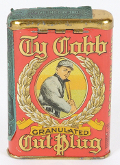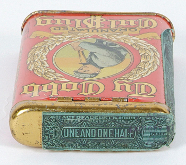Pristine Cobb tin -- with tax stamp -- to be auctioned by REA
March 7, 2012 -- A Ty Cobb Tobacco tin to be offered in the upcoming Robert Edward Auctions event likely will raise new questions about whether a Ty Cobb red portrait with the "Ty Cobb": King of the Smoking Tobacco World advertising back should be classified as a T206.
The Ty Cobb tins, like the cards that have the same back brand advertisement, are scarce. According to Jon Canfield of baseballandtobacco.com, there are fewer than 15 documented tins. Of those, REA’s example is the finest. But its importance is that it’s the only one that has a full tax stamp. The date on this tax stamp introduces new information about when the Ty Cobb tobacco was produced.
The stamp has within its design the words Act of August 5, 1909. However, a more significant date is one applied to the stamp at the time of packaging: Aug. 15, 1912. Though the factory number is not entirely legible, the state of origin is Maryland, noted on the stamp as “FACTORY 2? DIST. OF M.D.” This is interesting, because all Ty Cobb tins, including this one, have the Factory No. 33 4th Dist. of NC printed on the side.
Until now, collectors have dated the Ty Cobb tobacco issue to early 1910. The Ty Cobb brand of tobacco was a product of the F.R. Penn Tobacco Company. This tobacco company, like many others of the time, was controlled by the American Tobacco Company trust.
Advertisements for the Ty Cobb brand first appeared in the Macon Telegraph on Feb 8, 1910. Each ad was one line, and one or more ads were run in newspapers five of the next six days. The final day these ads ran was Feb. 13.
The only picture advertisement was in the Augusta Telegraph. This ad ran each Sunday for four consecutive weeks in 1910, beginning Feb. 20 through March 13.
No other advertisements have been found outside of those run during this time in the state of Georgia. This, coupled with the scarcity of the tins, has led many to speculate that the Ty Cobb brand was a short-lived product that wasn’t on the market for long.
The tax stamp on the REA example shows that even if the first offering in 1910 was brief, at least a second offering was made in 1912. In 1910 the product would have been produced by F.R. Penn, which was part of the American Tobacco Company trust. The 1912 product would have been produced by the new, smaller American Tobacco Company that was formed after the breakup of the trust.





